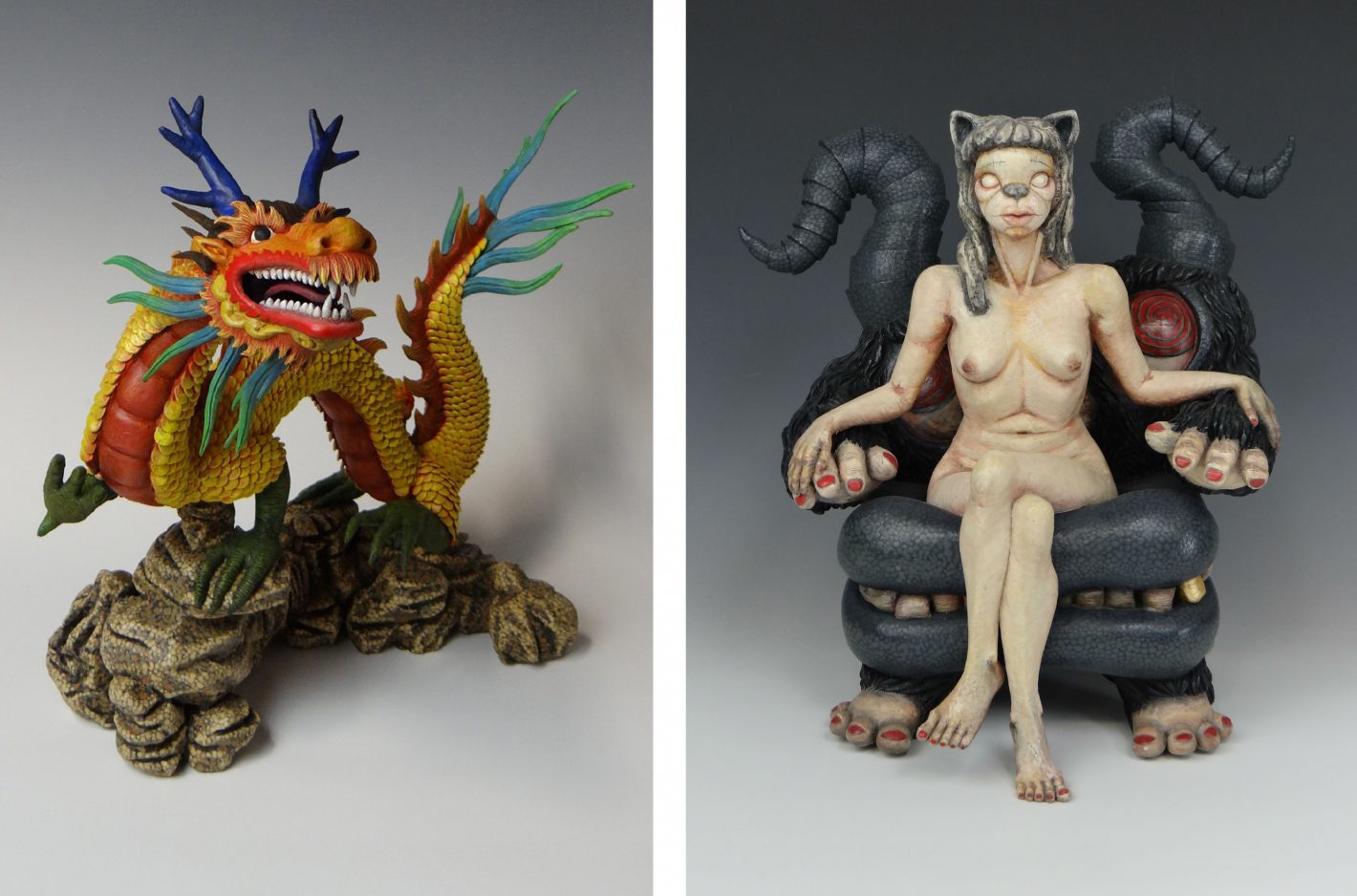 Left: Longing For You | Right: Anxiety
Left: Longing For You | Right: Anxiety
Alison Ye’s sculptures are at once grotesque and serene. Her work evokes the playful spirit of a sensitive soul whose openness allows her to tend the emotional landscape of her romantic experiences. With titles like Longing for You and Two Broken Soul, her work isn’t shy about sharing its feelings. Yet, at the same time—and perhaps in a way that marries form and content—Ye’s work is technically so complicated that it’s easy to fixate on her incredible craftsmanship and forget about the meaning or depth of her work altogether.
I first heard about her when I saw her show at Arc Gallery in San Francisco, and up close it feels like an emotionally developed version of Pee-Wee’s Playhouse where the baby-talk voices and ice cream soup make way for an intimate journey through the artist’s love life, and the word of the day (don’t scream) is honesty. While the subjects evoke the figurative aspects of these emotionally charged scenarios, they’re not obscured by dishonesty or obscured by opacity.
In the years since being an active sculptor, Ye has written a children’s book called Ally the Lovebird (also based on her love life), shown her work internationally as well as up and down the West Coast and amassed a squad of sentimental ceramic sculptures. Her Mood series reads like a collection of monstrous new emojis, and work from her Pain, Recovering and Loving Again, which explores stories of love and romance more in depth, will be opening at Fe Gallery on Feb. 9.
I had the chance to speak with Ye to discuss her background, her forthcoming motherhood and delved into the emotional depth behind her striking work.
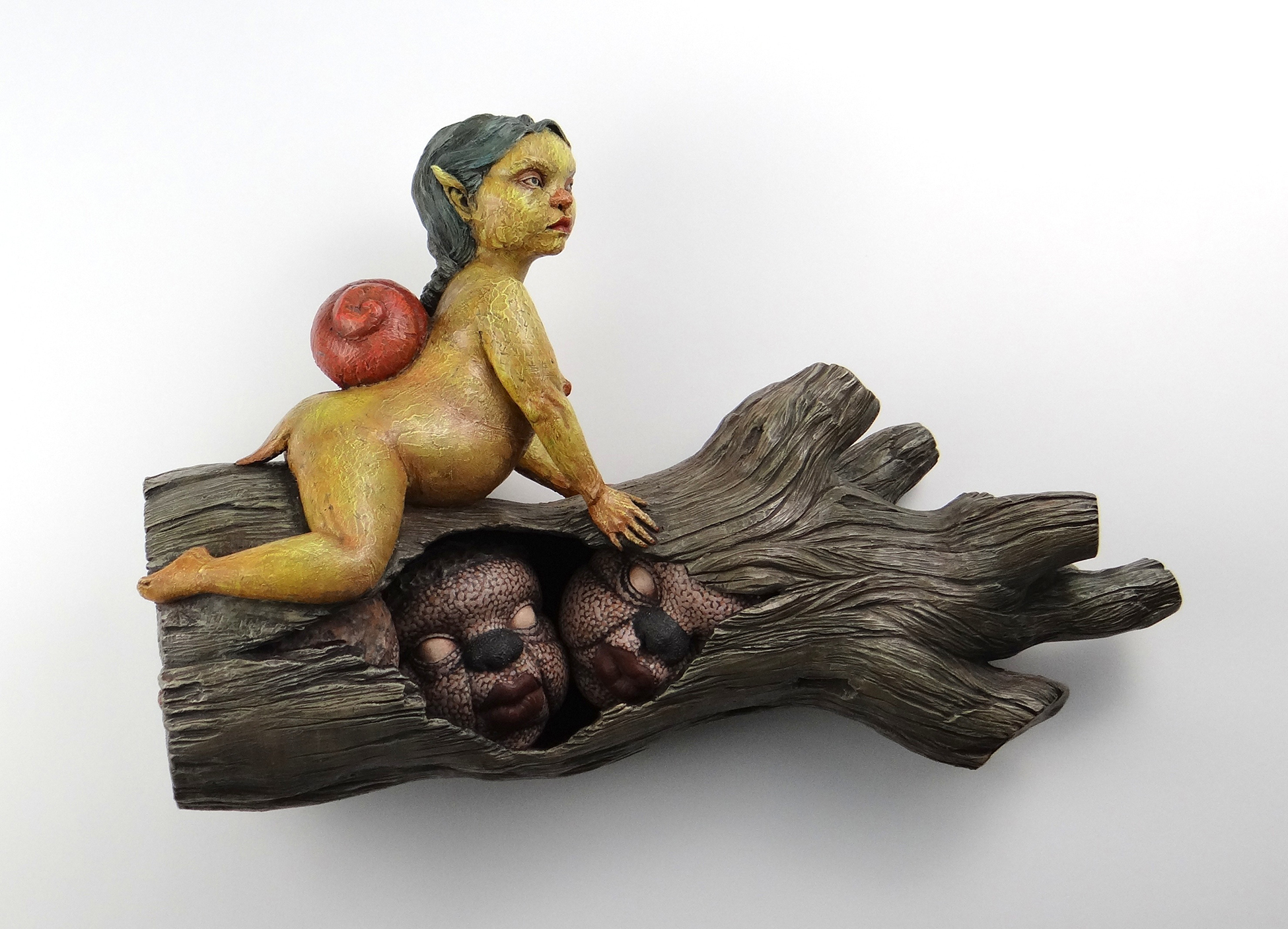
Forbidden Love
You wanna start by telling me a little bit about how you got started?
I’m originally from China and did my undergrad at Sichuan Fine Arts Institute. I studied Chinese ceramics and then I moved to America for grad school and got my diploma at the Academy of Art. The head of our department is a wonderful figurative artist, which is something I hadn’t done before because I was more into pottery-making stuff. She introduced me to including narratives in my work. So I started to play with different stories and realized I’m just very small. I can’t explore any big issues; it’s just not me. I’m just a very romantic and emotional person and always put my love life in front of anything else. So I started making sculptures that tell the story of my relationships and with different people that I had experience with and I feel like I’m playing a character—like a role in that relationship. Once I started developing work like that, I started making other friends. I was still new to America, so I was finding friends and asking about their stories, and through sharing stories, I started making characters based on them.
That’s really beautiful. Do you have recurring characters?
Actually, I do. I did a lot of lovebirds. Basically, those lovebirds are all characters. One of them is me, and the rest of them are my friends. I thought that I could develop a series, but unfortunately, I lost my interest, but I love them so much. If you go to my website, I actually wrote a book called Ally the Lovebird, which is a children’s book. This is the story of how I met my husband. I mean, how I got heart broke once upon a time, and then I met my husband, and we live happily forever. It’s that kind of story.
Looking at your work, these characters seem incredibly emotional. Do you get these attributes from the people in front of you? Using maybe the pig as an example, can you tell me what happened between your model and the sculpture?
That’s from a series called Mood and it’s basically all based on me. It’s like the altar that I put my emotions on. The pig one is called Artist. I’m sure you can relate to this because you’re also an artist. At some point I just got really, really sad. I didn’t feel like I was putting my heart and soul into my sculpture, and I felt like there was nobody out there who appreciated my work but me. There’s an ancient saying in Chinese; we say that you’re bleeding from all the holes in your body. It means like you’re going to die, like that’s the end of your life. That’s how I felt. I was so depressed and felt like I was bleeding through all of these holes, but I wanted to feel strong. I think that the pig is a character that lived in my heart, and I wanted to let it out.
Yes, you’re right, I can totally relate to that. Do you think pregnancy has influenced your work at all in a similar way?
Well, honestly I think so. I thought a lot about sculptures representing my son, but I don’t have a clear vision, yet. I’m due in March, and I really couldn’t say for sure right now but feel like when I see my son, it’ll probably change me a lot. Right now, I still feel like myself. I don’t feel like a mother yet. My son hasn’t been born yet. I can’t see him, I couldn’t feel that visual connection. Sorry if that sounds a little bizarre.
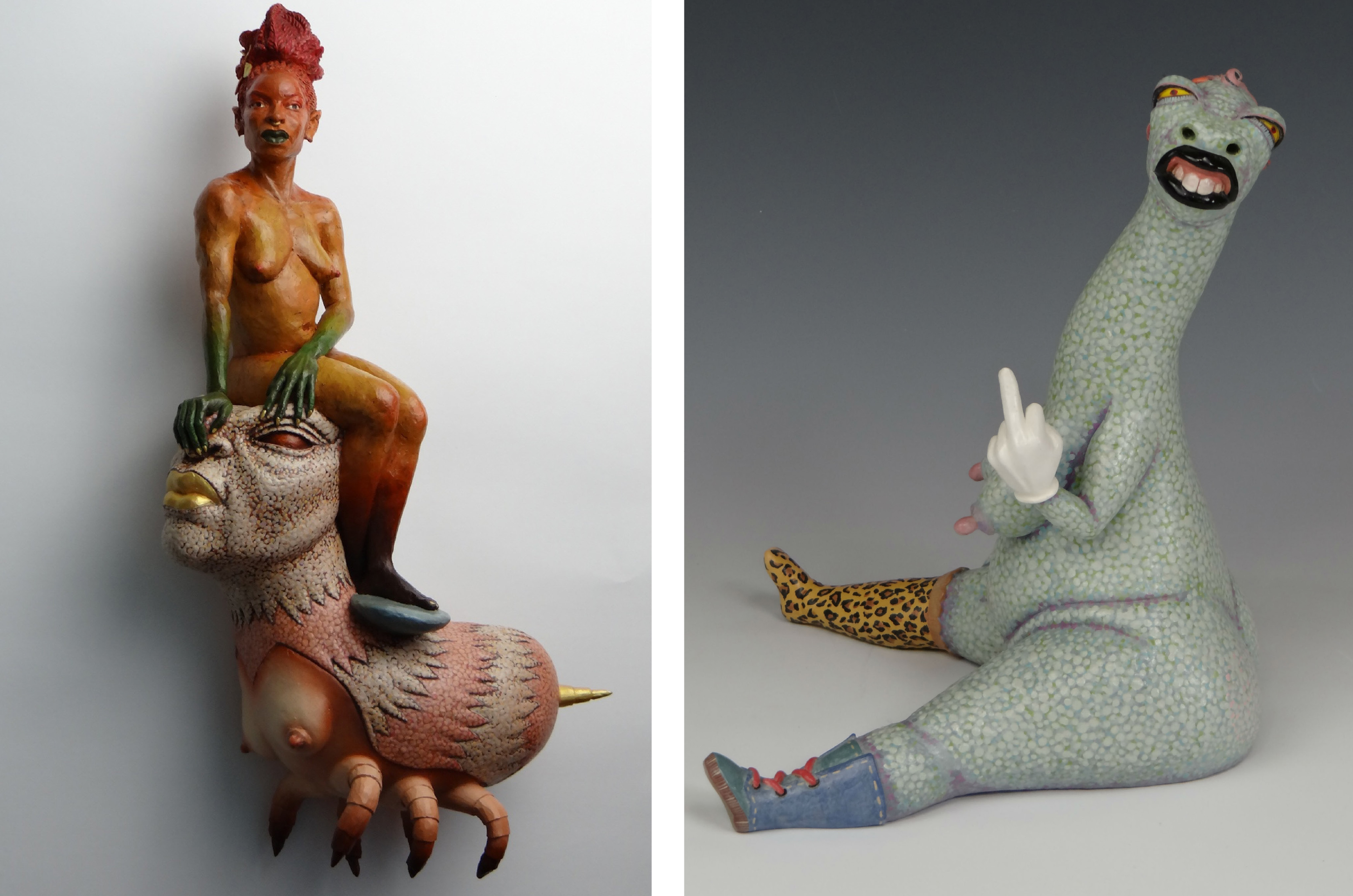
Left: Dreamer | Right: Statement
No, you know, I think it’s like so many other things; you don’t really know until afterward. A year from now you’ll be able to look back at your work and pinpoint how it’s changed you.
Yes, I feel like that’s true.
Speaking about that a little bit, do you know Fred Rogers, from the kid’s TV show Mister Rogers’ Neighborhood?
Oh my God, I love that show. I think it’s absolutely amazing. I just love everything about his TV show and his personality.
It’s funny because your work reminds me of something he said which is that it’s easier to talk about complex emotions when puppets are the ones doing the talking.
Oh, yes, I remember that from the documentary.
Do you think it holds true in your work? Is it easier to talk about these complex things when you’re doing it in an abstract way?
Yes, for sure. I think it’s completely true. Part of my concept is about the process of making my sculpture like telling a story. I express my emotions through my sculpture, because making a sculpture takes a really long time, so during the whole process I kind of like put my energy into sculpture and I’m not thinking about how sad I am. And at the end, I just grow out of that pain. It’s a recovery for me.
If you have a strong emotion and you decide to make a piece of work about it, is the emotion something that you hold tight in your head while you’re working, or do you just let the feeling go once you’ve decided to do the work?
My most recent work is a sculpture of a dragon, called Longing for You. It’s about missing my husband when he went on a trip to New York for a month. I was alone at home and had just found out that I was pregnant! It was hard. I felt completely alone … I missed him so much and I wanted to distract myself, so I decided to make the most challenging sculpture I could. Not only was my husband gone, but also my family is in China, and the dragon, for me, represents something deep inside in my heart. The dragon took me the whole month because there were so many technical failures. It wouldn’t stand alone. I couldn’t attach the tail because the whole thing is one ceramic piece. It’s very fragile. In that process, I healed myself and I was just focusing on the dragon for like eight hours a day.
Do you search for projects, or do you feel like projects find you in a way?
Projects find me, because I’m very emotional. Every little thing just makes me feel things.
That’s funny. I think it helps you probably, right? Writing is the same. Being emotional and vulnerable is kind of our superpower, you know?
Yes, exactly, and also I realized that writers and sculptors need to have some time alone, but at the same time I feel like we have to be observers. We just stop and take time to look around, probably see things most people would miss. I feel like my material is always there somewhere.
Can you talk about what you’re working on now? Do you have any upcoming series?
My style is continuing in the line of figurative work. More like an animal-human hybrid or like a fairy in fairyland, you know? I use a lot of figurative techniques in my work. Right now I’m working on this octopus. I haven’t finished yet, but that’s what I’m making right now.
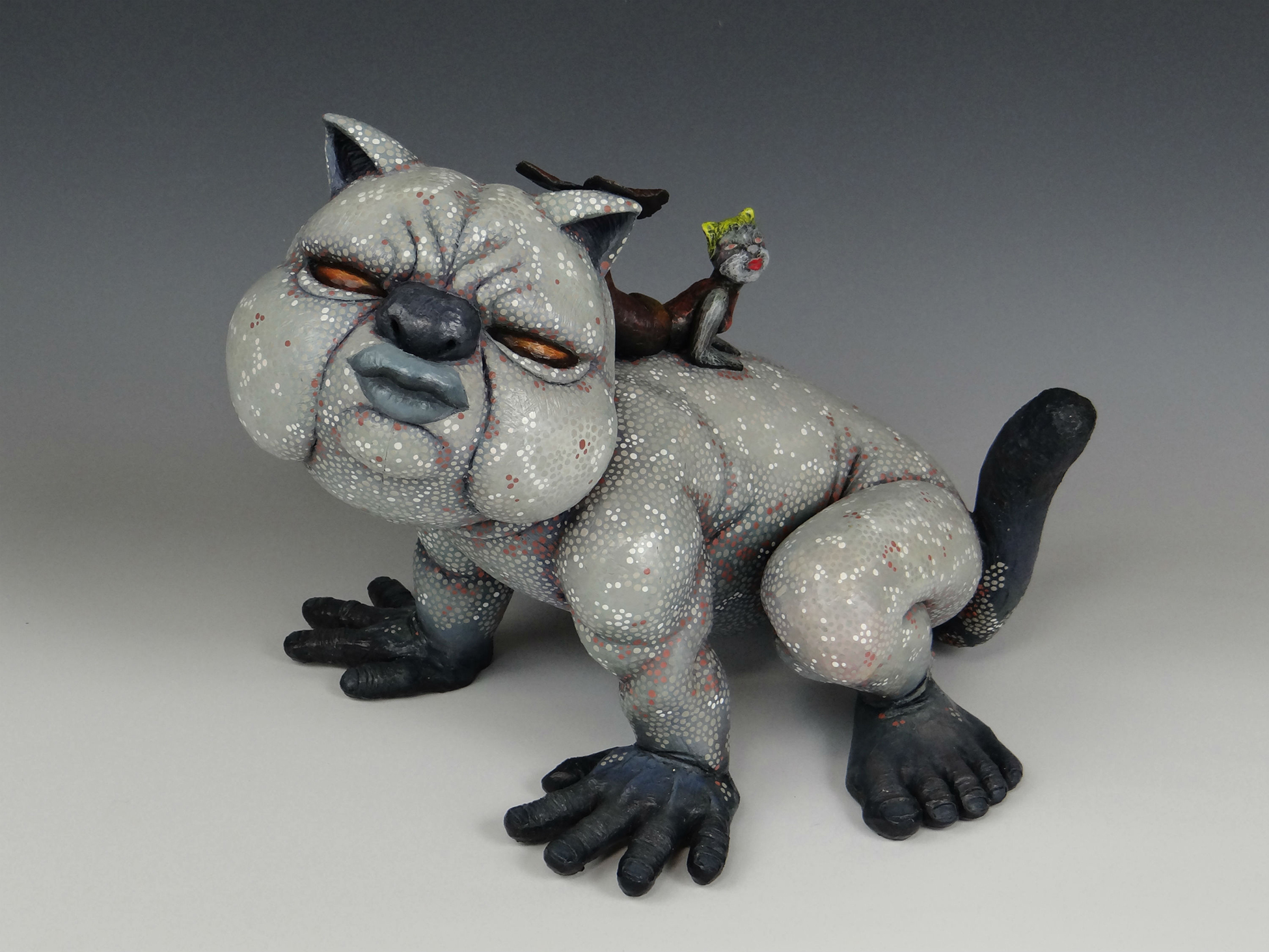
Coupling
Can you tell me the story behind it? Is this part of the Pain, Recovery and Loving Again series?
I think this is kind of influenced by me being pregnant. It’s going to be an octopus with a tiny little octopus. It’s about me and my son, but I don’t want to really make it too cheesy; I didn’t want it to be too literal but it’s definitely going to represent me and meeting my baby. It’s about this octopus. She’s alone and then she’s starting this new relationship, and it opens up her world. I want my work to be more universal. Perhaps some of my work is just completely locked in with this one person, but I want my work to represent a more universal concept. I want people to find their own stories in my work. If they see my octopus, they might think about something that happened in their lives … that opens their eyes and changes their lives. Not just as a pregnant woman, or a new mom.
You’re really able to encapsulate the emotions in that sculpture.
Yes, exactly. It’s just like the sculpture is taking so long to make. Sometimes one sculpture takes me like four months, because I’m making multiple pieces at the same time. You couldn’t possibly work only on one. You’re always working on this one, waiting for that one to get dry, and working on this one waiting for paint on that one. It can drag on like four or five months, and at that time I’m just emotionally done with the sculpture.
Wow, yes, I didn’t realize that it took that long. With that in mind, you’re pretty prolific, Alison!
I’m trying, I’m just finding the time and work as hard as I possibly can. But I feel like I can’t stop. I’m not myself if I stop doing my sculpture, and there is nothing else that makes me happier than producing.
Alison Ye’s sculptures will be part of the group show Dreams of Our Own alongside the work of Richard Black, John Krempel and Zsalto. The exhibit opens Saturday, Feb. 9, 2019, at 6 p.m. at Fe Gallery (1100 65th St., Sacramento). For more info, go to Fegallery.com.
**This piece first appeared in print on pages 18 – 19 of issue #284 (Jan. 30 – Feb. 13, 2019)**

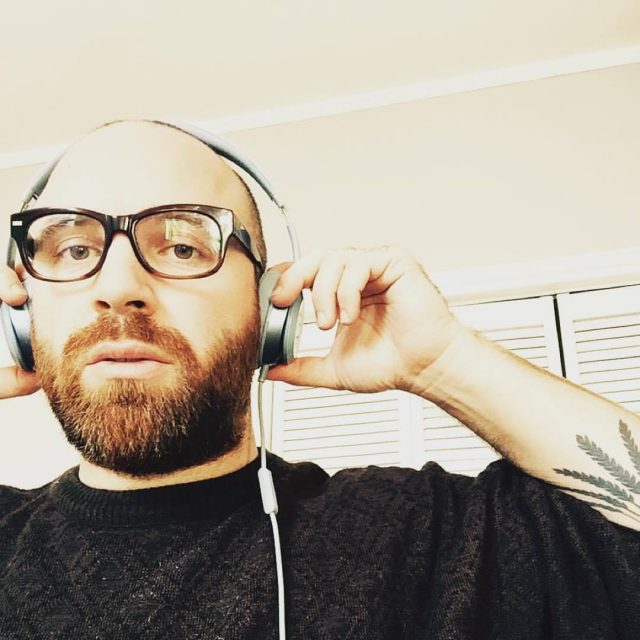
Comments